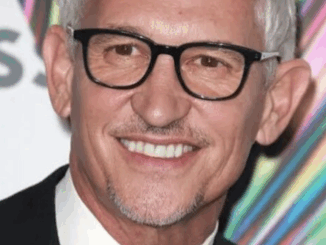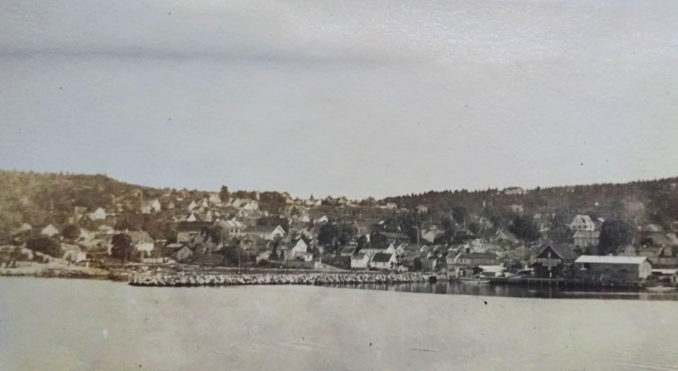
In the previous episode of Mystery Album, we visited Gotland, gateway to the Baltic and Sweden’s largest island, which lies 100 miles south of Stockholm and 225 miles northeast of Malmo. The above near century-old reproduction can most honestly be captioned, ‘Unkown township-cum-port somewhere along the Swedish coast.’ Your humble reviewer of photographs had better luck with the next old photo as he recognised it. Or rather, recognised the statues about the middle of the top of the building.

Roughly halfway between the mid-1920s and now, I was obliged to the occasional foray from Copenhagen to Stockholm. Before all this malarky with bridges and tunnels, and after the days an English gentleman might stroll the promenade deck while sailing past Gotland, one travelled overnight by train and train ferry. The train ferries ran from 1892 until 2000 when they were replaced by a direct rail line over and under the Øresund that separates Denmark and Sweden.
According to my dog eared and faded expenses, I would leave Kobenhavn Hovedbanegard at quarter past ten at night and reach the coast at Helsingor 40 minutes before midnight. In the shadows of Hamlet’s castle, the train was divided and the international through carriages shunted onto the train ferry. Forty minutes was allowed to cross the sound that connects the Baltic and the North Sea. A Scandinavian efficient seventeen minutes later, the train had been reassembled on the Swedish side at Helsingborg. Click on the links to see what it looked like:
Photo 1: The carriages approach the ferry.
Photo2 : The ferry has rails for the carriages, as well as space for cars
Photo 3: The carriages sit inside the ferry for the crossing.
Photo 4: From the outside it looks like this.
Photo 5: At the other side of the sound, the carriages are shunted off the ferry and the train reassembled.
Seven hours and two minutes were allowed for the 368 mile trip across southern Sweden to the capital. If, for the duration, one was trapped in the dining car with a hard-drinking Lapp iron ore miner, a pretty German count’s seventeen-year-old granddaughter (for licencing purposes pretending to be 21) and a 90-year old Finn with an accordion, then so much the better. The mobile phone and tablet computer had not been invented. We made our own entertainment. One staggered onto Vasagatan just as the four-faced gold-crowned clock (with winged wheel embellishment) standing on a column outside Stockholm Central struck 07:30 AM.
This was before Sweden was in the Common Market and you could shop until you dropped VAT free. However, they didn’t knock the tax off at the till. Oh no. Everything was packaged up Ikea style in an Ikea style box. A million forms were filled. The box and paperwork were taped up with indestructible Saab/Volvo style stickie metal tape. The VAT could then be reclaimed at the frontier. Awkward if hoping to gorge on tax-free perishables during a stay. Being further delayed in the high latitudes might result in a VAT dodger being weighed down by a box of rotting goo, or risking an emergency there and back dash to Soviet-occupied Estonia. A tall tale for another time.
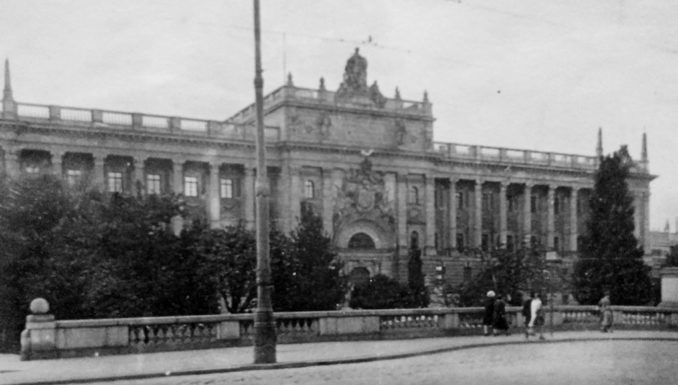
On the other side of the Baltic, and in happier times, the Swedish parliament building was built between 1897 and 1905, two decades prior to our mystery family’s visit. Even without reference to Wiki, every Puffin knows Stockholm’s seat of government is an Aron Johansson neoclassical design complimented with baroque revival elements. The statue is Moder Svea, or Mother Sweden, flanked by representations of Swedish womanhood and manhood in Aristotelian perfection. In the Johansson representation, the Valkerie shieldmaiden holds a sceptre denoting sovereignty, rather than the usual sword.
As well as opening railway lines on Gotland, King Oscar II ruled Sweden between 1872 and 1907. During his time, parliament gained influence over the monarch until parliamentarianism proper was established in 1910 with full universal suffrage being achieved in 1921, just before the above image was captured. Known as the Riksdagen or Riksdagshusetit, the legislature sits on the island of Helgeandsholmen with the tip of Moder Svea’s crown standing 115 feet above pavement level. The Swedish Social Democratic Party has been in power for much of the time since, with their brand of progressive consensus liberalism influencing government even when not in power with, as we shall see, cataclysmic outcomes.
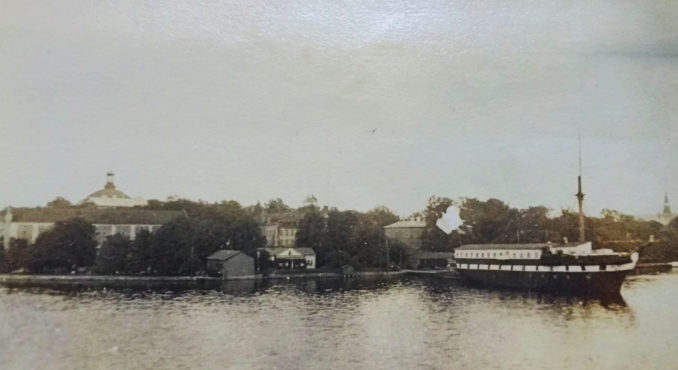
Having established that we’re in Stockholm, one is then forced to ponder, “How many three decked wooden sailing ships with eleven gun positions to starboard has the Swedish navy had?” The answer is not many, making the vessel to the right identifiable as HSwMS Vanadis, pictured in her dotage missing a mast and a funnel and being used as a shore facility. In passing, that’s why naval bases are pre-fixed ‘HMS’, back in the day they consisted of tied up old warships.
A well-known photograph, similar to our own Turner’s Fighting Temeraire, shows the Vanadis being towed away to the breakers. Held by the Stockholm Stad Digitala Stadsmuseet, the image is captioned,
“Frigate Vanadis last trip. Outside Kastellholmen and with Beckholmen to the left and Fafangan visible in the background. Two tugboats help.”
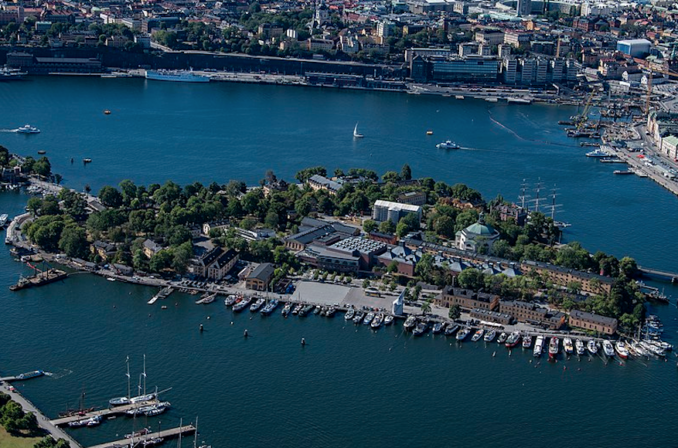
Svenska: Skeppsholmen och Kastellholmen,
L.G. Foto – Licence CC BY-SA 4.0
Although the Vanadis’ mooring is not mentioned, it is identifiable by reference to the other named locations. When photographed, the ship was moored on the left-hand side at the top of the island of Skeppsholmen. A building with a domed roof stands out in both photos. It is the Eric Ericsonhallen, formerly the Skeppsholm Church. The island is Skeppsholm island, in the 1920s a military establishment guarding the entrance to central Stockholm in the same way that in a previous instalment Holmen baval base guarded the entrance to Copenhagen.
As for the vessel herself, Vanadis was a steam frigate built at Karlskrona shipyard and launched in 1862. The Swedish Navy owes me a favour or two and were kind enough to forward a facsimile of the ship’s log. Some of the writing is scratchy. My Swedish isn’t great. Not to worry. She first got her feet wet in 1863, her maiden voyage from Sweden to Ryde on the Isle of Wight was followed by a tour of the Eastern Med. The following year, she visited the Eastern Seaboard of the United States and the Caribbean. 1855-56, back to the Caribbean via Plymouth with a return to Sweden via North Africa. In 1867-68 she sailed all the way to Rio de Janeiro and back, with another tour of the Western Med the next year.
Her most notable voyage took place fifteen years later. Leaving Sweden on December the 5th 1883, Vanadis did not return until the 9th of May 1885 having embarked upon what became known as the ‘Vanadis Expedition’. A sailing expedition for scientific purposes around the world anti-clockwise, out via the Atlantic, back via the Pacific. Taking a month to pass from Lisbon to Rio she travelled down the east coast of South America, reaching Valparaiso in Chile on 6 March 1884 having braved Cape Horn and the Roaring Forties. She arrived at Callo in Peru twenty four days later.
According to annotations contained within the log, high and low points included:
In Sheerness, a boat came loose when it was to be lowered and four men from the crew were injured. A storm later put the ship into operation so it collided with the English monitor Hydra, but none of the ships received any major damage.
During the visit to Lisbon, H. M. the King and H. K H. the Crown Prince of Portugal paid a visit on board.
In Valparaíso, the President of the Republic paid a visit on board.
During a goat hunt on the island of Nouka Hiva, a crewman fell so hard in the mountains that he later died the same day.
In Papeete, H.M. The King of Tahiti visits aboard. In Honolulu, they were honoured by a visit from the native ruler, King Kalakau.
On 15 September at anchor in Shanghai, she was hit by a violent hurricane, but they managed to prevent it from coming into operation with reserve anchors and machine power. However, the ship’s boats sustained some damage and a steam locomotive came into operation and sank but could later be salvaged.
On April 6, 1885, one of the Grand Mars’ guests fell on deck and died immediately. He was buried ashore on his arrival in Gibraltar a few days later.
When she returned to Sweden on May 9, 1885, she had been at sea effective sailing time of about 11 months, of which the longest time from port to port was 28 days on the journey between Lisbon and Rio de Janeiro. The commander was Commander O. Lagerberg. Second was Captain H. of Klintberg.
Taking five months to cross the Pacific, French Polynesia was visited as well as Tahiti and Honolulu en route to Kobe, Japan. Also on the Pacific leg, she was immortalised when visiting Jaluits Island (see below). Presumably meaning Jaluit Atoll, part of the Marshall Islands, in those days a German protectorate.
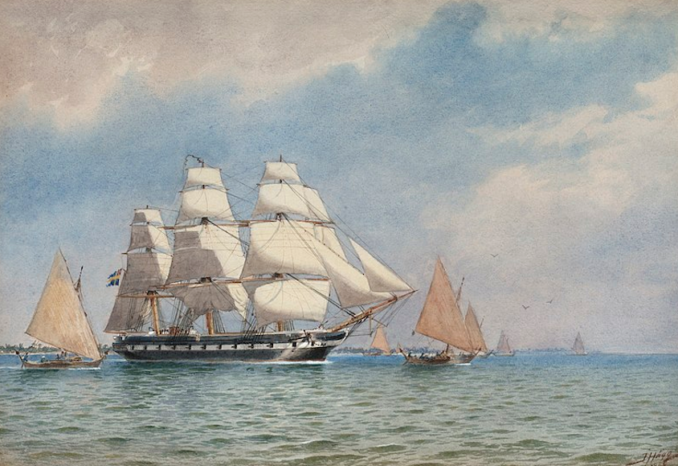
The Vanadis approaching the island of Jaluit in the South Seas 1884,
Jacob Hagg – Public domain
One crewman was the interesting Crown Prince Oscar, Duke of Gotland, whose father King Oscar II opened the GJ Railway in a previous episode of Mystery Album. The Prince served in the Swedish Navy for 25 years rising to be a Vice-Admiral. A muscular born again Christain, three years after his around the world expedition, during a trip to Bournemouth, Oscar married his sister in law’s lady in waiting. Having married outside of Royal blood he was stripped of all his Swedish titles (including Duke of Gotland) but kept the foreign ones including the ubiquitous Danish Order of the Elephant that had been presented to him in 1880. On his trip around the world, he had also been ennobled to the Hawaiian Order of Kamehameha I and the Brasilian Grand Cross of the Southern Cross. His wife being of an aristocratic background, he found himself spoilt for choice when it came to titles and ended up as Prince Bernadotte, Count of Wisborg.

Oscar Bernadotte, Svenskt porträttgalleri,
Public domain
Inspired by our own Keswick convention, Prince Bernadotte founded the Södertälje Conferences in 1898 where he was a lay preacher of some repute. The municipality being stuck up a canal in Stockholm County, our mystery family are more likely to be familiar with Keswick than with Södertälje, perhaps fortuitously so. In recent decades, as a result of Sweden’s liberal view of immigration, the picturesque town has been enriched with 39 percent of the city’s population now being first or second-generation immigrants, mainly from the Middle East. The notorious Södertäljenätverket operates in the city. The infighting within this mafia-style organisation resulted in bombings in the city in 2019.
Vanadis retired from service in 1893 and became a shore establishment, finally being decommissioned and scrapped in 1939. If we take another look at her old resting ground at Skeppsholmen, above we can see the long harbour front of Stadsgardsleden. Since the Vanadis was pictured close to, we shall assume it was photographed from the channel as the mystery family arrived in Stockholm by sea. In our mind’s eye they are stepping down the gangplank at the Stadsgarden terminal and next time on Mystery Album, we shall follow in their footsteps.
© Text and photos unless otherwise credited Always Worth Saying 2021
The Goodnight Vienna Audio file
Audio Player

